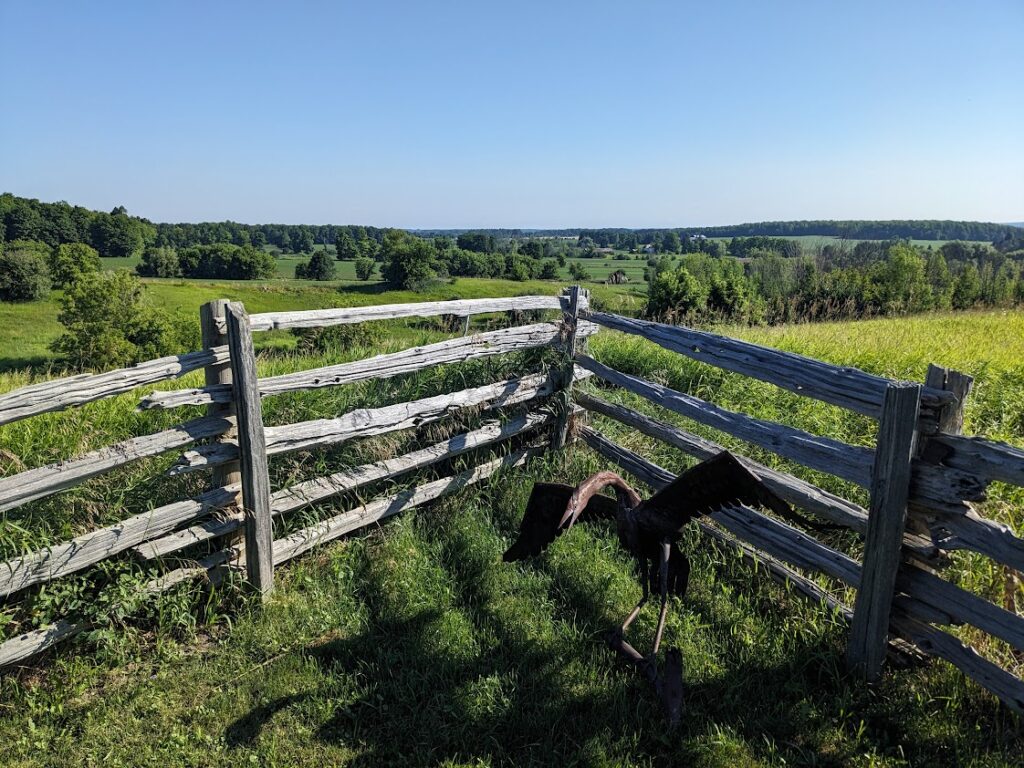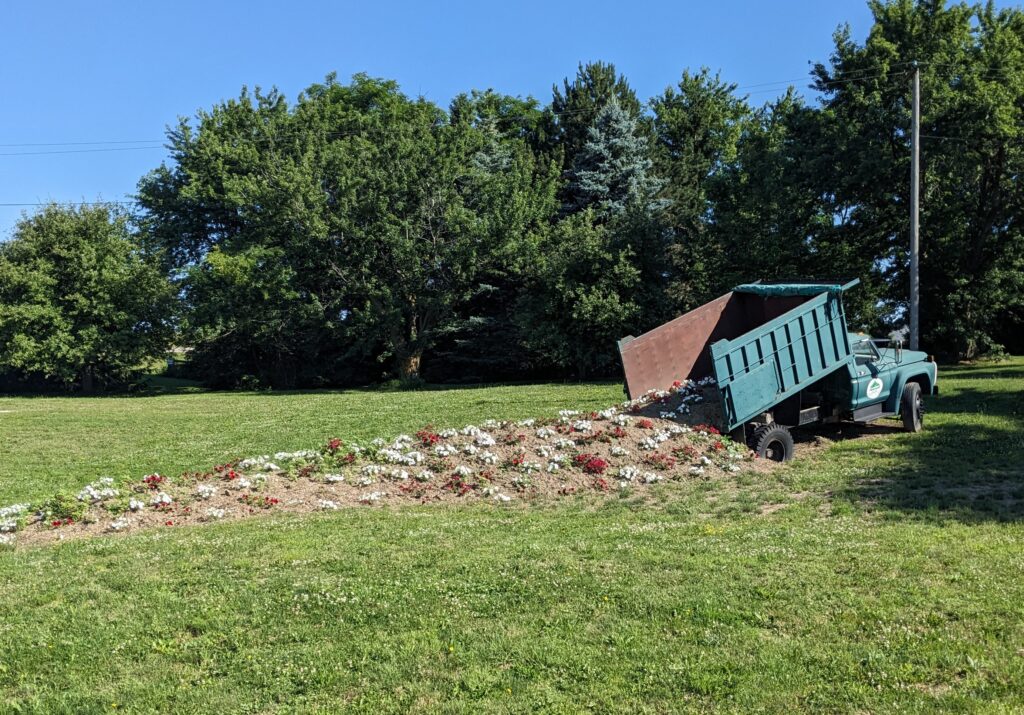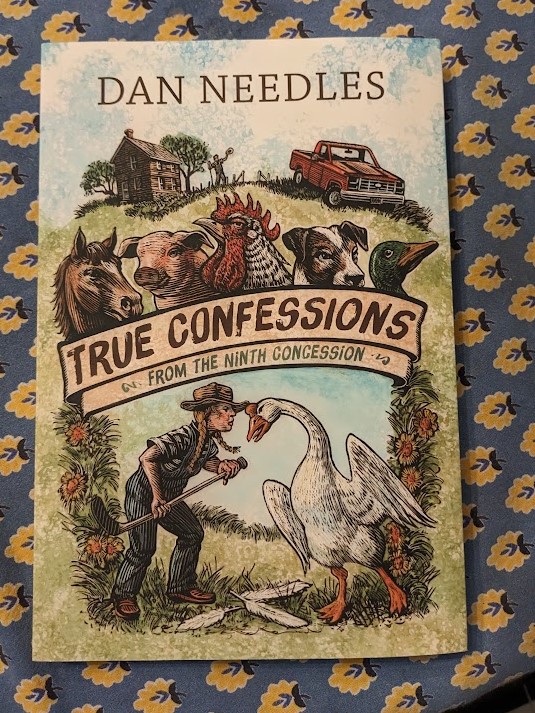According to an article I have been reading on line there were once about 30 to 60 million buffalo roaming across the Prairies and through woodlands of North America. Although, in fact, they were probably bison, as the buffalo is native to Africa and Asia. Today, you can knock off around four zeros to calculate the number roaming free in Canada. Overhunted in the nineteenth century, they were facing extinction. Luckily, thanks to projects to reintroduce them, there are now about 2,200 Plains Bison and about 11,000 Wood Bison roaming wild in Canada.We haven’t seen any yet, but then again, until today, we have been hovering around Toronto and the suburbs, where we have only spotted small fry: buckets of tree squirrels, ground squirrels and chipmunks.
And I have been getting déjà vu. It is more than thirty years since we last travelled to Canada. We arrived in the early weeks of a chilly Spring, with an infant daughter asleep on the back seat of an old green Chevy Caprice that we planned to drive across to the west coast. Today, we are sitting in the same living room of the same friends we visited all those years ago, and no time seems to have passed at all, except that our infant daughter now has one of her own. And this time we have decided to fly across the country instead of having to spend countless hours crossing the prairies by car. In the meantime, we are heading north for a day of exploring a more rural Ontario. Hopefully, too, we’ll find a breath of fresh air, as it is incredibly muggy in Newmarket. And perhaps a buffalo or two?
Rosemont. This small, wayside hamlet is the home of a well-known local restaurant, The Globe. Originally, this lovely old building was a regular staging post, where weary passengers, drivers and horses could have a well- earned rest from bouncing over the rough country roads. Exploring the internet, I discovered that the hotel was established in 1859, and even found an article about the number of ghosts residing there. Today, we will meet the man who helped to establish it as an iconic restaurant and put Rosemont on the map. Although he no longer cooks for the restaurant, he is keen to cook for us at home. A chef of suitably rotund build, Arthur Needles worked at the Globe for well over thirty years, so he is well connected in the area, and – before feeding us – took us on a Cooks Tour (literally) of his neighbourhood.
Our first stop, only a few minutes from his house on the outskirts of Rosemont, is at Maple Grove Farm and Market in Mulmur, Ontario, owned by the Wallace Family. This popular spot consists of a renowned bakery, a café, and a shop selling locally made and locally grown produce, including their own delicious strawberries. We get a brief peek behind the scenes, when Arthur introduces us to the baker, who is busily whipping up fresh scones filled with fresh, but slightly damaged raspberries and white chocolate.
It is something I am rapidly discovering about North Americans: everything is garnished. Usually with sugar, maple syrup or some other sweetener. I understand at last the influence behind the Filipino sweet tooth! Roaming the wide aisles of a local supermarket, I discover a plethora of flavours for every product, and struggle to find a box of plain black tea, or a sausage without a dozen added extras. Soda water has a hundred fruity flavours, and mayonnaise a million iterations. Add to the enormous volume of packaged, preserved food a propensity to jump in a car for every minor chore and suddenly, the modern obesity issue makes sense. Although I must admit the last factor is understandable. Local roads are as wide as English motorways. And the strip malls stretch for miles. In this humidity, or through winter snow, who would choose to walk?
However, the day is sunny, we are in a farmyard, not a retail park, and all the produce here is freshly made or grown. Wandering through the barn-sized store, we gaze upon trays of cookies, cakes and the quintessentially Canadian speciality, butter tarts. And surprise, surprise, the butter tart is a rich, super-sweet dessert: a pastry cup filled with corn syrup and caramelized brown sugar, eggs and butter. For me, a dollop of cream or some pecan nuts added to the mixture is vital to cut the incredible sweetness, but it’s a firm favourite with Canadians, and is often adapted to regional or personal tastes.
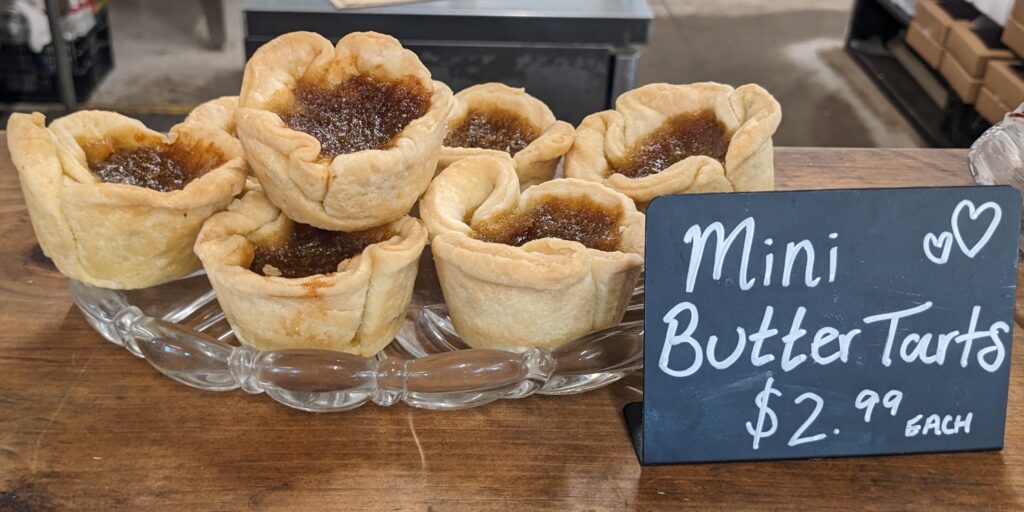
For the more savoury toothed gourmand, there are sausage rolls and sandwiches, cheese bread, artisan pizzas and home-made quiches, some of which we will enjoy later for lunch. Local producers sell their pickles and preserves, fresh meat and fresh vegetables.
Maple Grave market was established five years ago. It is a labour of love, according to Chris Wallace, a place where he can sell his fresh produce direct to the consumer. Starting out as an engineer, the land he grew up on called Chris home in 2004, when he and his wife Robyn bought a property near his parents farm. Here, they have raised their five kids, and here they grow strawberries and soy beans, sweet corn, field corn and straw for the horses that are bred and trained in the neighbourhood.
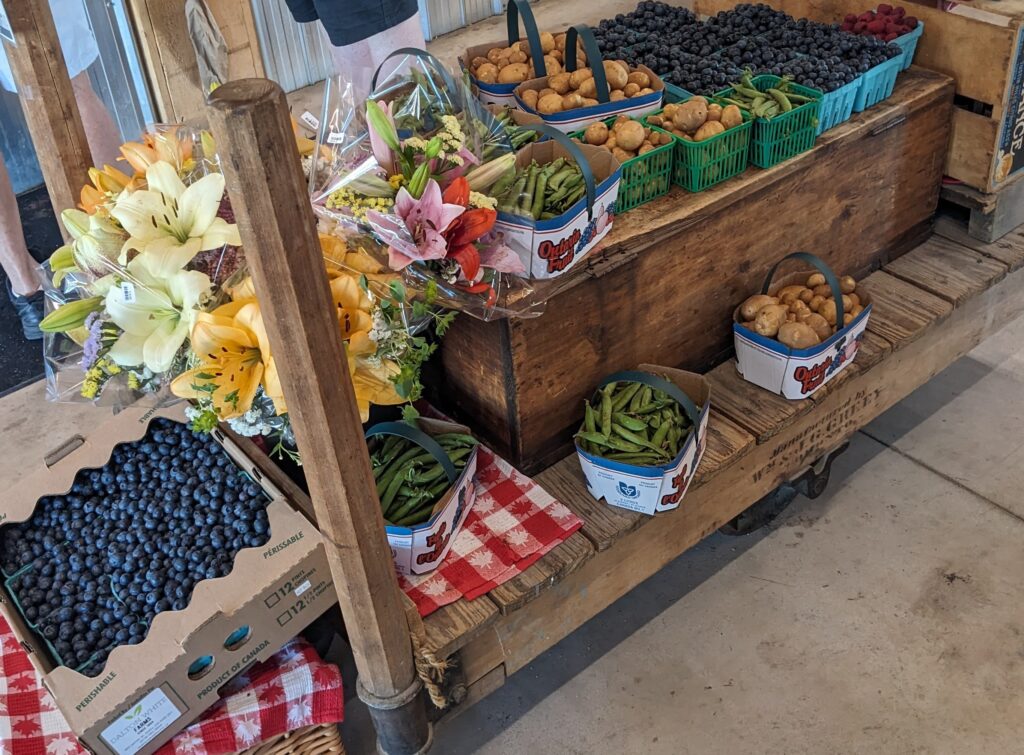
Loading us into the family ‘bus’ Chris has kindly taken time out of his busy day – the grass needs harvesting today, but he must wait for it to dry off from the morning dew before he can start – to show us over his property. As we pass the various crops, Chris explains the process of growing and harvesting each one.
We admire row upon row of strawberry plants and hear about the complicated process of growing strawberries that will continue to produce fruit throughout the year – or at least until Thanksgiving. We learn that the straw produced for livestock consists of alfalfa (lucerne) and Timothy grass, a primary source of fibre in a horse’s diet. Originally from Europe, Timothy is now popular in Canada, where it is grown predominantly in Manitoba.
And the difference between field corn and sweet corn? Sweet corn has a higher sugar content, picked before the natural sugar has a chance to turn into starch, and is still plump, sweet and juicy. Field corn is taller, tougher and dented. Popular for animal feed, it needs to be milled for human consumption, before being converted into corn syrup, corn flakes, cornflour or corn chips.
We also pop in to say hello to some of Chris’s herd of cows, but sadly I don’t get to meet Isla and Fiona, their new Highland calves that I have noted on their Facebook page. These smooth coated, creamy cows are currently camping with Ken, a neighbouring farmer who leases out a paddock or two, while producing maple syrup on the rest. Ken points out the forests of maple trees beyond the house, interspersed with the skeletons of several dead trees. These are ash trees, deciduous trees that can live up to a hundred years. Yet they are being systematically destroyed by the emerald ash borer, a species of East Asian wood-boring beetles which have killed millions of trees in Canada alone.

On a happier note, Ken teaches us about the production of maple syrup. Although not quite the iconic product in Australia that it has become in North America, we are nonetheless delighted to take away a small sample. Canada produces almost all the world’s maple syrup – 88% of it coming from Quebec, according to Ken. No wonder the maple tree has become the national emblem and its jagged leaf takes its place at the centre of the Canadian flag. In Canada, maple syrup must be made of pure maple sap, with none of the ‘added extras’ that may be used in the States, and the syrup must have a specific density to be marketed as maple syrup. Nonetheless, many Americans prefer the imitation corn syrups because they are both sweeter and cheaper.
On the way home, we drop by to inspect the local fire station, with its four huge and shiny fire trucks. Apparently Art was a volunteer here for many years, and he is keen to introduce us to Captain Mike and his new drone for spotting fires, and Fireman Andy, who shows us round the station and introduces us to the complicated procedure of fighting country fires.
Then it is home to Art’s house, overlooking a verdant hillside, where a cool breeze blows away the heat of the day, and the local cheese bread melts in our mouths and goes beautifully with a crisp, dry rosé. We don’t spot any bison, but Art is keen on ‘birding’, so perhaps we can settle in for a spot of bird watching instead…
But no, we are off again. This time to talk books and cooking around the kitchen table with Art’s brother, Dan, and Dan’s wife Heath, while we try out some snappy Canadian gins. Dan Needles is a local author and playwright. Think along the lines of James Herriott. Dan is no vet, but he loves living in the country. We talk at length about the years he travelled and worked in Australia. Later I read about travel experiences in France and British Columbia, speech writering for a Canadian politician and a popular newspaper column. How he took his columns and created a long-running TV series about the fictional Wingfield Farm. And those columns are now in book form, one of which I am reading with glee. (It’s always good to have something to read aloud to the One & Only on a long car trip!)
Heath, too, has a story to tell. As we sip on a lilac-coloured gin, she shows me photos of many of the glorious wedding cakes she made in her large over-crowded kitchen. And sip lilac-coloured gin. Empress 1908 Indigo Gin is made by Victoria Distillers, and it is a nod to the legendary Fairmont Empress Hotel in Victoria, British Columbia. Combining a classic Empress tea, a handful of botanicals, and of course a splash of gin, they claim to have created ‘a unique gin that pairs traditional juniper notes of a London Dry with a modern flavour profile.’ It is certainly very easy to drink on a hot afternoon, as the dogs mooch around our feet, and the volume rises…
…Until we are dragged away by the wonderful and ever-enthusiastic Arthur, who had made plans for our dinner by the pool, with his lovely wife Linda and a large, friendly Weimaraner with a craving for steak…
A superb end to a fascinating adventure, and many thanks to our wondrous and hospitable hosts.
*With thanks, too, to the One & Only for his photos, and with apologies to Maple Grove Farm for cheekily borrowing the snap of their gorgeous Highland cows.

